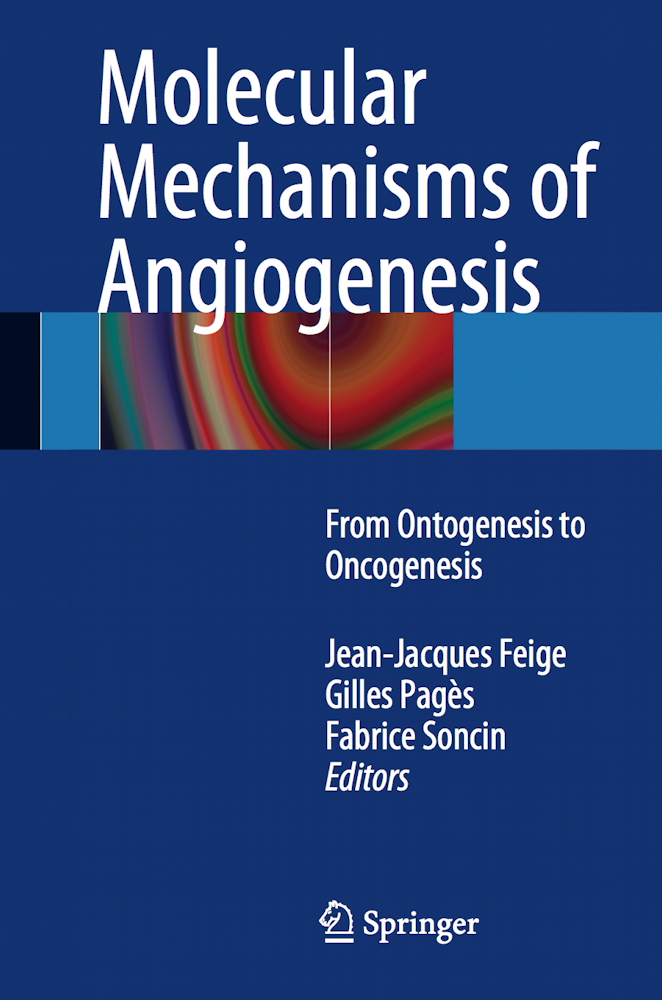
Édité par Jean-Jacques Feige, Gilles Pagès et Fabrice Soncin
Research Signpost
ISBN:
978-2-8178-0466-8
2007, 230 pages
Molecular mechanisms of angiogenesis: From ontogenesis to oncogenesis. | |
 |
L'angiogenèse est un processus en plusieurs étapes qui contrôle la formation de nouveaux vaisseaux sanguins et lymphatiques à partir de vaisseaux pré-existants. Ce processus est très actif au cours de l'embryogenèse, en grande partie inactif pendant l'âge adulte, mais est réactivé lors de la cicatrisation des plaies et dans un certain nombre de situations pathologiques telles que le cancer et les maladies oculaires d'origine vasculaire. Outre les cellules endothéliales qui tapissent les parois des vaisseaux, plusieurs autres types cellulaires (péricytes, macrophages, cellules progénitrices, ...) contribuent à l'angiogenèse. Un certain nombre de voies de signalisation sont activées pour réguler très finement les événements morphogénétiques qui conduisent à la formation de néovaisseaux étanches et stables.
 Chapter 1
Chapter 1
Emergence of endothelial cells during vascular development
Eichmann
et al.
Pages 3-23
 Chapter 2
Chapter 2
Lymphatic vascular morphogenesis
Tatin F
et al.
Pages 25-44
 Chapter 3
Chapter 3
Finding new partnerships: The function of individual extracellular receptor domains in angiogenic signalling by VEGF receptors
Hyde Caroline AC
et al.
Pages 47-75
 Chapter 4
Chapter 4
Wnt/Frizzled signaling in the vasculature
Couffinhal T
et al.
Pages 77-97
 Chapter 5
Chapter 5
BMP9, BMP10, and ALK1: An emerging vascular signaling pathway with therapeutic applications
Bailly S
Pages 99-119
 Chapter 6
Chapter 6
Apelin signaling in retinal angiogenesis
Audigier Y
et al.
Pages 121-148
 Chapter 7
Chapter 7
Emerging role of the two related basic helix-loop-helix proteins TAL1 and LYL1 in angiogenesis
Pinet V
et al.
Pages 149-167
 Chapter 8
Chapter 8
Hypoxia and extracellular matrix remodeling
Muller L
et al.
Pages 171-197
 Chapter 9
Chapter 9
Sphingosine-1-Phosphate in hypoxic signaling
Cuvillier O
Pages 199-217
 Chapter 10
Chapter 10
Reciprocal crosstalk between angiogenesis and metabolism
Laurent G
et al.
Pages 219-233
 Chapter 11
Chapter 11
Endothelial progenitor cells and cardiovascular ischemic diseases: Characterization, functions, and potential clinical applications
Smadja D M.
et al.
Pages 235-264
 Chapter 12
Chapter 12
Endothelial cell reactions to oxygen: Implications for cancer
Oliveira RL
et al.
Pages 267-282
 Chapter 13
Chapter 13
Tumor angiogenesis and lymphangiogenesis: Microenvironmental soil for tumor progression and metastatic dissemination
Paupert J
et al.
Pages 283-306
 Chapter 14
Chapter 14
Angiogenesis and Invasion in Malignant Glioma: Friends or Foes?
Daubon T
et al.
Pages 307-324
 Chapter 15
Chapter 15
Role of endothelial cells in tumor escape from immunity
Soncin F
Pages 325-337
 Chapter 16
Chapter 16
Tumor high endothelial venules and lymphocyte trafficking
Veerman KM
et al.
Pages 339-352
 Chapter 17
Chapter 17
Posttranscriptional regulation of angiogenesis through AU-rich mRNA degradation: potential application in cancer therapy
Planel S
et al.
Pages 353-372
 Chapter 18
Chapter 18
Antiangiogenic drugs in cancer therapy: Effect on advanced renal cell carcinoma
Négrier S
Pages 375-382
 Chapter 19
Chapter 19
Anti-angiogenic therapies in colorectal cancer
Eveno C
et al.
Pages 383-396
 Chapter 20
Chapter 20
Resistance to antiangiogenic treatments
via upregulation of substitution pathways
Grépin R
et al.
Pages 397-419
 Chapter 21
Chapter 21
VEGF-A splice variants: Do they play a role in tumor responses to Anti-angiogenic therapies?
Eymin B
et al.
Pages 421-442
 Chapter 22
Chapter 22
Progenitor endothelial cells as biomarkers of Anti-vascular agents
Taylor M
et al.
Pages 445-460
 Chapter 23
Chapter 23
Soluble Vascular Endothelial (VE)-Cadherin: Toward a marker of endothelial dysfunction
Sidibé A
et al.
Pages 461-478
 Chapter 24
Chapter 24
The prognostic and predictive value of VEGF across various tumor types
Pallaud C
Pages 479-492